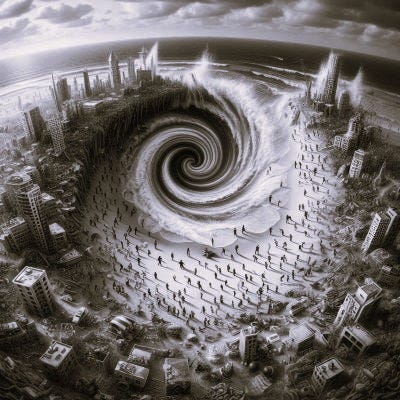Donald Trump never fails to surprise. But the bombshell that he dropped at his press conference with visiting Israeli prime minister Benjamin Netanyahu on February 4, 2025, was of a completely different magnitude.
He suggested that the United States take over the Gaza strip, develop it into the “Riviera of the Middle East”, and take a “long-term ownership position”. “This could be so magnificent,” he said. It’s not every day that foreign policy sounds like a real estate sales pitch.
If this wasn’t already enormously controversial, Trump also reiterated that Palestinians currently living in Gaza should be relocated, appealing to countries “with humanitarian hearts” to accommodate them. This is particular ironic and hypocritical, given that Trump on the same day signed an executive order to withdraw all funding from the UN Relief and Works Agency for Palestine Refugees in the Near East (UNRWA).
Contrary to his usual reluctance to deploy US forces abroad, he also said his administration would “do what is necessary” when asked about sending troops there. By Wednesday, the administration was already walking back parts of the proposal and sought to clarify that any resettlement of Palestinians would only be temporary. There was also some pushback from Republicans, including Senators Rand Paul and Lindsay Graham and former national security advisor John Bolton.
But by now, the world should have learnt to not to dismiss outright what Trump says, no matter how outrageous it sounds. And true to form, the president doubled down on his proposal on Thursday in a post on his Truth Social network.
Claiming that no US troops would be needed – because the “Gaza Strip would be turned over to the United States by Israel at the conclusion of fighting” – he re-upped the idea of resettling Palestinians and envisioned “the construction of what would become one of the greatest and most spectacular developments of its kind on Earth” in the Gaza strip. All of this, in Trump’s view, would mean that “stability for the region would reign”.
This is by far the most extreme proposal on the future of Gaza and its people ever to be made by a US president – or any other serious political leader. So much so, that even Netanyahu approvingly conceded that Trump was “taking it to a much higher level.” And shortly after Trump aired his proposal, Netanyahu’s defence minister, Israel Katz, announced on X that he had ordered his troops “to prepare a plan that will allow any resident of Gaza who wishes to leave to do so.”
Elsewhere, of course, rejection of what would amount to the ethnic cleansing of over two million Palestinians and another illegal occupation of Palestinian lands was universal.
This may be more of a problem than Trump imagines because Gaza is just one piece in a much more complicated puzzle of US Middle East policy.
For starters, there are now serious doubts on the future of the ceasefire between Hamas and Israel, with talks about its second phase just started. This also raises questions about what Trump meant when he envisaged taking over Gaza from Israel “at the conclusion of fighting”. It is almost as if he assumes a breakdown of the very ceasefire that he claimed his victory in November’s presidential elections was key in achieving (which is true, according to many observers, but leaves one to wonder why it then took more than two months to get there).
In the longer term, the injustice that Palestinians would rightly feel over experiencing another large-scale forced displacement – comparable in scale to the 1948 Nakba – would lead to yet more radicalisation among them.
A future US occupation of Gaza – already questionable from an international legal perspective – would not confer sovereignty, let alone what Trump calls a “long-term ownership position”. Deportations, in particular, are illegal under the fourth Geneva convention of 1949, to which the United States is a signatory.
Even if it were legally and logistically possible to relocate over two million Palestinians, the impact on Trump’s preferred recipients – above all Egypt and Jordan – would be highly destabilising to their social cohesion. It would also further strain their struggling public services, potentially beyond breaking point. The region is already reeling from the freezing of USAID programmes that Trump mandated in an executive order on the day of his inauguration. In 2024, Jordan received $1.4 billion of aid from USAID, Egypt $215 million, and the West Bank and Gaza $918 million.
Not only is the future of this US support to the region much in doubt but humanitarian assistance has also generally become less of a priority to many governments in the global north. With the rebuilding Gaza estimated to cost billions of dollars and to take many years, Trump’s proposal looks even less like a carefully considered plan.
The combined impact of the drying-up of foreign assistance and the proposed mass displacements of Palestinians from Gaza risks to condemn millions of people and the communities receiving them to decades of deprivation and suffering. The resulting desperation would be the perfect breeding ground for violence and a rich environment for recruitment efforts by terrorist organisations.
Trump’s plan for Gaza also imperils the broader Middle East strategy that he has articulated so far. It does clearly not sit very well with the idea of achieving normalisation between Israel and its Arab neighbours, especially Saudi Arabia.
Even before his shocking announcement on February 4, the foreign ministers of Egypt, Jordan, Saudi Arabia, the UAE, and Qatar, as well as the Secretary General of the PLO, had written a joint letter to Trump’s secretary of State, Marco Rubio, and urged him to work with them on implementing the two-state solution for the Israeli-Palestinian conflict that Trump now has all but doomed.
While Rubio backed Trump’s plan, Saudi Arabia’s crown prince Mohamed bin Salman condemned it in no uncertain terms, unequivocally ruling out normalisation with Israel in the absence of a viable Palestinian state.
Without Saudi backing, Trump’s other signature Middle East policy – a regional, US-backed alliance against Iran to force Tehran “to make a great deal” – will also struggle to get off the ground. A return to his maximum pressure campaign against Iran is now certain following an executive order to this effect. But without broader Arab-Israeli rapprochement, the success of this policy will be more limited.
For years, Tehran has managed to exploit the plight of the Palestinians and the lack of Arab support for their cause. Iran has forged an alliance of proxies and enlisted them in the fight against Israel while also mobilising anger among ordinary Arabs and channelling it against the ruling monarchies in the Gulf states.
The regime in Tehran may be weaker now than at any time in the past decade as a result of repeated air strikes against by Israel and the wars against Hamas and Hezbollah, but the conditions that allowed it to become a dangerous regional power are still there.
The atrocities committed by Hamas during its attacks against Israel on October 7, 2023, and Israel’s disproportionate retaliation afterwards have intensified the salience of the Palestinian cause across the Arab world. Ruling regimes across the region would ignore this at their peril, and Trump will lose valuable US allies if he persists with his plans for mass-deportations of Palestinians and the establishment of a US presence in Gaza.
At its heart, Trump’s outline of the deal he envisages for Gaza builds on his 2020 plan for the Middle East and the Abraham Accords. But rather than making either of these more workable, it only holds the prospect of more human suffering, alienates important partners and allies in the region and beyond, and potentially may even require the US military to the kind of overseas expedition that Trump normally detests.
It is not a policy that makes anyone safer in the region or serves American interests. Trump of all people should recognise an all-around bad deal when he sees one. But even if he does and the proposal in its current outline is never implemented, the effects on the region will be overwhelmingly negative and long-lasting.
So, the real problem is not whether his proposal is workable, but rather that Trump has used his megaphone to disrupt and thereby created turmoil where none was needed while helping to normalise a deeply illegal and immoral idea.
This is an updated and expanded version of a commentary published by Channel News Asia on January 25, 2025.
We hope you'll share Navigating the Vortex with anyone you think might find it of interest. Also, you can listen to our podcast editions via the website and on all major podcast platforms, including:












